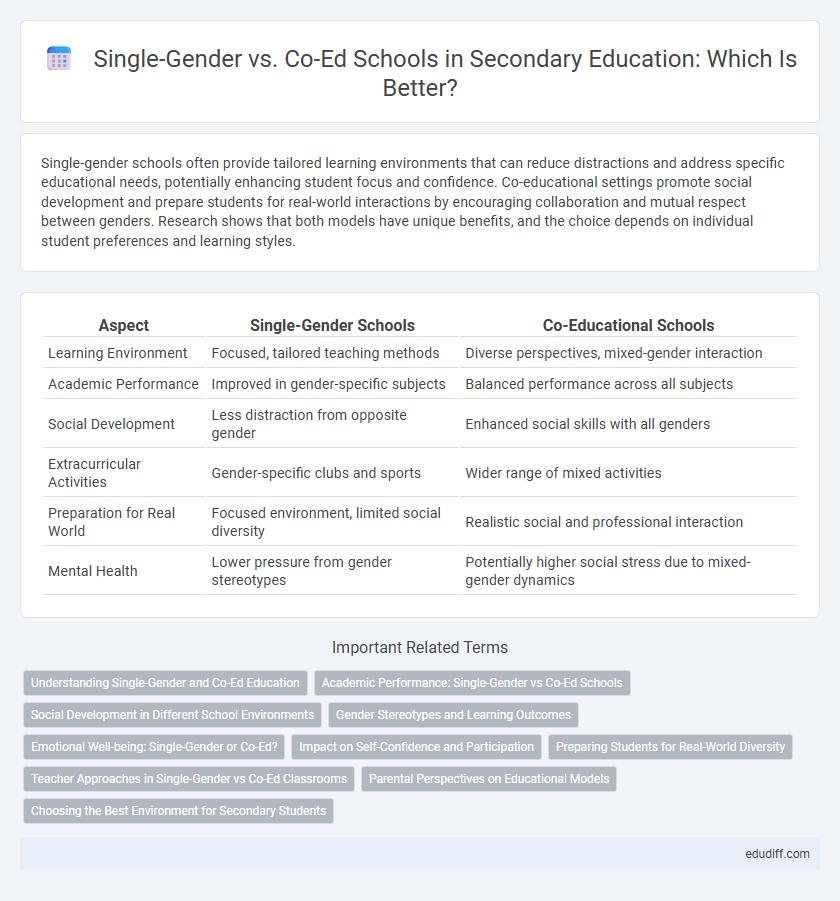Single-gender schools often provide tailored learning environments that can reduce distractions and address specific educational needs, potentially enhancing student focus and confidence. Co-educational settings promote social development and prepare students for real-world interactions by encouraging collaboration and mutual respect between genders. Research shows that both models have unique benefits, and the choice depends on individual student preferences and learning styles.
Table of Comparison
| Aspect | Single-Gender Schools | Co-Educational Schools |
|---|---|---|
| Learning Environment | Focused, tailored teaching methods | Diverse perspectives, mixed-gender interaction |
| Academic Performance | Improved in gender-specific subjects | Balanced performance across all subjects |
| Social Development | Less distraction from opposite gender | Enhanced social skills with all genders |
| Extracurricular Activities | Gender-specific clubs and sports | Wider range of mixed activities |
| Preparation for Real World | Focused environment, limited social diversity | Realistic social and professional interaction |
| Mental Health | Lower pressure from gender stereotypes | Potentially higher social stress due to mixed-gender dynamics |
Understanding Single-Gender and Co-Ed Education
Single-gender education separates students by sex, aiming to tailor teaching methods to gender-specific learning styles and reduce distractions. Co-educational (co-ed) schools integrate boys and girls in the same learning environment, promoting social interaction and diverse perspectives. Research on academic performance and social development shows mixed results, highlighting the importance of considering individual needs and school resources when choosing between single-gender and co-ed education.
Academic Performance: Single-Gender vs Co-Ed Schools
Research indicates students in single-gender schools often demonstrate higher academic performance, particularly in subjects like math and science, due to tailored teaching methods and reduced social distractions. Co-ed schools foster diverse social skills and collaboration, which can enhance critical thinking and problem-solving but may dilute academic focus in some cases. Academic outcomes vary significantly depending on individual learning styles, school resources, and teacher effectiveness rather than the gender composition alone.
Social Development in Different School Environments
Single-gender schools often provide environments that reduce social distractions, allowing students to focus more on academic and personal growth, which can enhance self-confidence and leadership skills. Co-educational settings promote diverse social interactions and help students develop communication and collaboration skills by engaging with peers of different genders. Research indicates that social development in both environments varies significantly, with single-gender schools fostering deeper same-gender peer bonding and co-educational schools better preparing students for real-world social dynamics.
Gender Stereotypes and Learning Outcomes
Single-gender schools often reduce gender stereotypes by tailoring teaching methods to specific learning styles, resulting in improved academic outcomes for students. Co-educational environments promote social skills and gender inclusivity but may inadvertently reinforce traditional gender roles through peer dynamics. Research shows mixed results, with single-gender settings benefiting focus and confidence, while co-ed settings enhance collaboration and real-world preparedness.
Emotional Well-being: Single-Gender or Co-Ed?
Single-gender schools often create environments that reduce social pressures and stereotypes, promoting stronger emotional well-being among students by allowing them to express themselves without gender-based judgment. In contrast, co-educational settings provide opportunities for socialization with diverse peers, fostering emotional resilience through real-world interactions and collaboration across genders. Research indicates that both models have benefits, with single-gender schools excelling in emotional safety and co-ed schools enhancing emotional intelligence and communication skills.
Impact on Self-Confidence and Participation
Single-gender education often fosters higher self-confidence and increased participation among students by reducing social distractions and gender-based stereotypes. In co-ed settings, diverse interactions can enhance social skills but sometimes contribute to self-consciousness, particularly during adolescence. Research indicates that tailored teaching approaches in both environments significantly influence students' engagement and self-assurance.
Preparing Students for Real-World Diversity
Single-gender schools create environments that minimize gender stereotypes, allowing students to focus on academics without social pressure. Co-educational schools provide daily interaction with peers of different genders, fostering communication skills and empathy necessary for diverse workplaces. Exposure to mixed-gender settings better prepares students to navigate real-world social and professional diversity by promoting collaboration and mutual respect.
Teacher Approaches in Single-Gender vs Co-Ed Classrooms
Teacher approaches in single-gender classrooms often emphasize tailored instructional strategies that address gender-specific learning styles, such as increased verbal engagement for girls and kinesthetic activities for boys. In contrast, co-ed classrooms require teachers to balance diverse behavioral dynamics, fostering collaborative skills and promoting gender inclusivity through mixed-group discussions and activities. Research shows that adaptive teaching methods in single-gender settings can improve academic outcomes, while co-ed environments enhance social development and prepare students for real-world interactions.
Parental Perspectives on Educational Models
Parental perspectives on single-gender versus co-educational models reveal diverse priorities, with many valuing tailored learning environments that address gender-specific developmental needs. Research indicates parents often perceive single-gender schools as beneficial for reducing distractions and improving academic focus, while co-ed models are favored for promoting social skills and gender inclusivity. Surveys show that parental preferences are influenced by cultural background, perceived academic outcomes, and the desired social environment for their children.
Choosing the Best Environment for Secondary Students
Choosing the best environment for secondary students involves evaluating academic performance, social development, and emotional well-being in single-gender and co-ed schools. Research shows single-gender settings can reduce distractions and tailor teaching methods to gender-specific learning styles, while co-ed schools promote diversity, social skills, and preparation for real-world interactions. Parents and educators must consider individual student needs, learning preferences, and social adaptability when selecting between single-gender and co-ed environments to optimize educational outcomes.
Single-Gender vs Co-Ed Infographic

 edudiff.com
edudiff.com